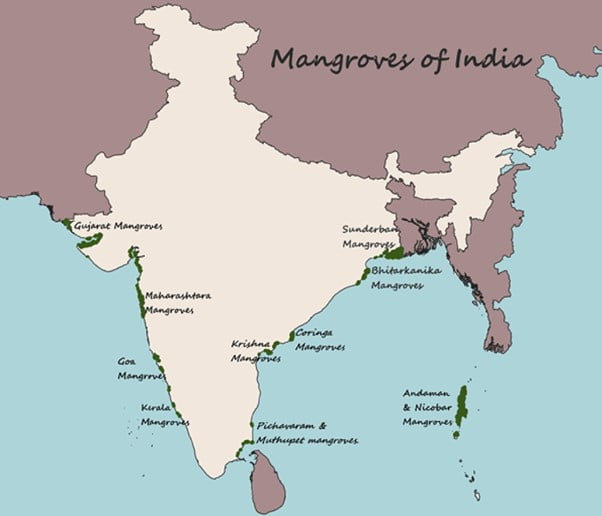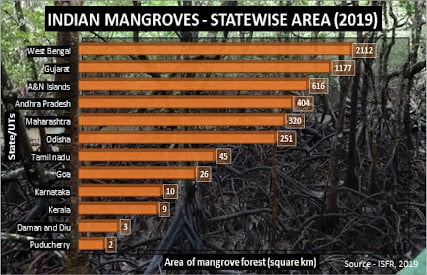Environment & Ecology
In News: A new ecological restoration technology developed by Indian scientists for ecological restoration is helping in revival of mangroves degraded due to rising sea levels, climate change and human intrusion in the Sundarbans in West Bengal.
- The project was initiated with help from the Department of Biotechnology in 2013 and is now likely to be extended to 100 acres; while the transplantation started in 2014.
Bio-restoration:
- It means reviving native ecosystem in degraded areas while maintaining diversity of original flora and fauna through regeneration but bringing down the regeneration period to four-five. Natural regeneration takes longer time to regenerate.
- Ecological restoration technology involves plantation of native salt-tolerant grasses and a diverse set of carefully identified mangrove species in different zones of degraded mangrove patches. It also involves the use of growth-promoting bacteria.
- The process begins with stabilising entire site of restoration by planting native salt tolerant grasses. An onsite mangrove nursery was developed to propagate mangroves for transplantation. Besides local mangroves and associate species, the nursery also grew threatened, endangered, and vulnerable species.
- In all, 22 species of mangroves and associate plants were grown to maintain native diversity.
- Mangrove forests having high diversity are more stable than those having less species diversity and diverse multispecies mangrove forests are more resilient to sea level rise.
- Small coastal patches of mangroves are highly vulnerable and fragmentation of the ecosystem is creating barriers to species movement and dispersal.
Mangroves in India:

- As per the Indian State of Forest Report of 2019, mangrove cover in the country is 4,975 square km, which is 0.15% of the country’s total geographical area.
- The largest area under mangroves is in West Bengal (Sundarbans).
- Indian mangroves consist of 46 species representing about 57% of the world’s mangrove species.

- In India, the mangroves are mostly located in the river estuaries and deltas; backwaters and islands.
- Broadly classified into three regions
- Deltaic or Eastern Coast Mangroves
- Estuarine & Backwater or Western Coast Mangroves
- Insular mangroves or Andaman & Nicobar Islands
- Deltaic or Eastern Coast Mangroves
- West Bengal – Sundarbans
- Odisha – Bhitarkanika (combined delta of the Mahanadi, Brahmini and Baitarani)
- Andhra Pradesh – Coringa (the Gautami-Godavari river)
- Tamil Nadu – Pichavaram and Muthupet mangrove (Cauvery)
- Puducherry mangroves.
- Estuarine & Backwater or Western Coast Mangroves:
- Gujarat(Gulf of Kachchh, Kathiawar; Gulf of Khambhat estuaries)
- Maharashtra (Mumbai, Thane creek)
- Goa coast – Zuari and Mandovi estuary
- Kerala Mangroves (Kannur, Kasaragod, Kozhikode, Ernakulam, Allepey)
- Daman and Diu mangroves
Miscellaneous:
- The Sundarbans is a protected wetland under the Ramsar Convention and is also a UNESCO World Heritage site.
Source: Down to Earth
Previous Year Question
Q.1) Consider the following pairs: (2014)
Wetlands : Confluence of rivers
- Harike Wetlands : Confluence of Beas and Satluj/Sutlej
- Keoladeo Ghana National Park : Confluence of Banas and Chambal
- Kolleru Lake : Confluence of Musi and Krishna
Which of the above pairs is/are correctly matched?
- 1 only
- 2 and 3 only
- 1 and 3 only
- 1, 2 and 3











